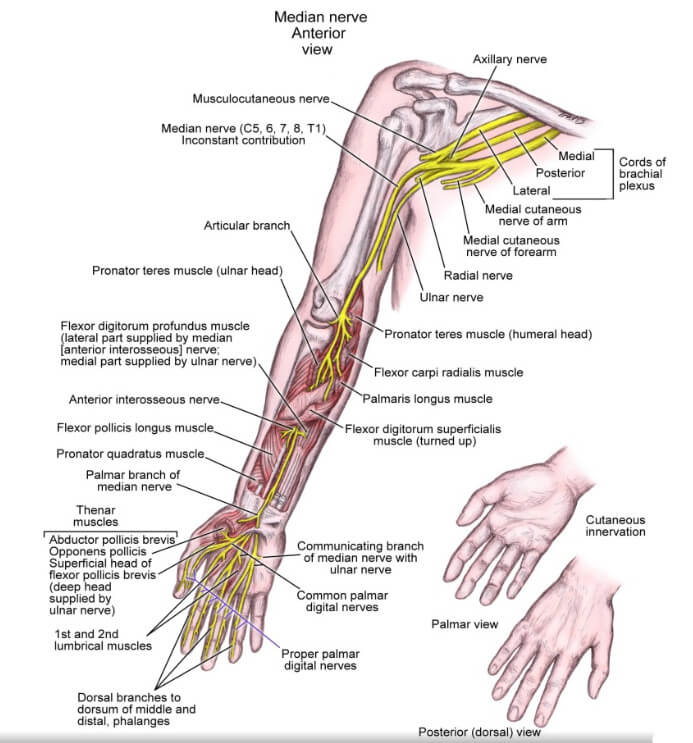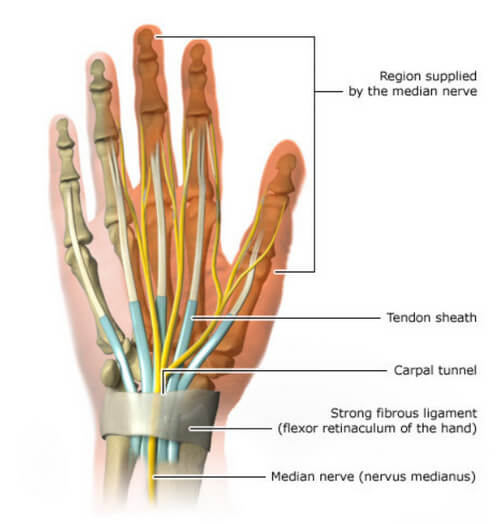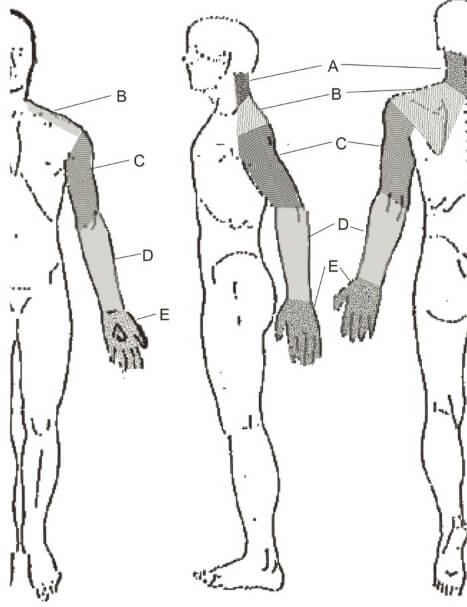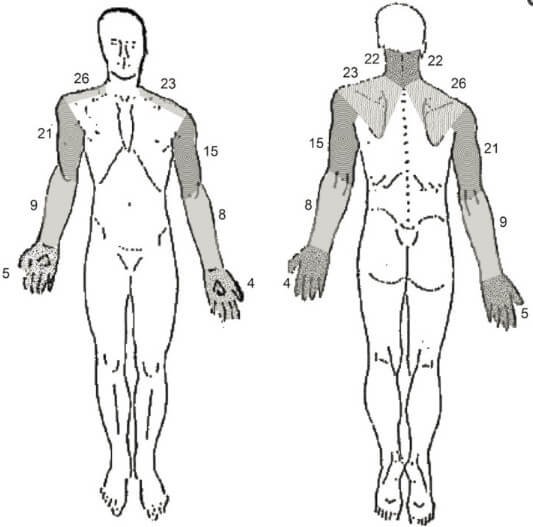This topic has been very controversial over the last few years. The reason for this is due to the workplace and personal injury claims.
Also, there has been a huge increase in computer use at home and in the workplace, which some had thought was part of the issue.
Another major concern is continuous repetitive movements in the workplace or in sports. Many have even suggested a psychological or stress related cause. (1)
The main topic of discussion is the baseline cause of forearm pain. Physicians have to be very comprehensive in receiving history from patients who complain of forearm pain. (5) In this article, you will review the possible causes or diagnosis related to forearm pain as well as the specific symptoms and treatments of each.
Forearm Anatomy
The anatomy is important for left or right forearm pain. Bellow you can see the complexity of what all is involved in such a small portion of your body.
Elbow
i. Joints:
- Humeroulnar joint- for flexion and extension
- Humeroradial joint- for flexion and extension as well as pivoting or rotation.
- Proximal radioulnar joint- for supination and pronation, or turning the hand with palms up or down.
ii. Ligaments
- Anterior medial collateral ligament (AMCL)
- Lateral collateral ligament (LUCL)
- Anular ligament
iii. Muscle groups
- Biceps brachii
- Brachioradialis
- Brachialis
- Triceps
- Anconeus
- Supinator
- Pronator quadratus
- Pronator teres
- Flexor carpi radialis
iv. Nerves
- Median nerve – initiates in C5-T1
- Ulnar nerve – initiates from C8-T1
- Radial nerve – initiates from C5-C7 (5)

Picture source : medscapestatic.com
This image is a complex example of the anatomy of the arm. Seeing the complexity of this system can help you to understand why there are so many possibilities to injury.
b. The forearm
i. Muscles
- Flexor profundus
- Flexor carpi radialis
- Palmaris longus
- Flexor digitorum superficialis
ii. Bones
- Radius and Ulnar- are in contact at the ends and work as a team (7)
c. Hand
i. Bones and joints
- There are 27 bones in the hand.
- Carpus
- Metacarpus
- Fingers (phalanges)

This image helps you to see the many bones involved in hand movement. The complexity of the hand is many times involved in forearm pain.
Picture source : www.ncbi.nlm.nih.gov
ii. Muscles
- The hand has over 30 muscles that work together in order to function correctly.
iii. Tendons and connective tissue
- In this image, you can see the tendons as well as the nerve passage. The area affected by carpal tunnel is highlighted as well.

Picture source : www.ncbi.nlm.nih.gov
iv. Nerves
- Median nerve – supplies the flexor policies brevis, opponents pollicis and abductor pollicis brevis. (3)
Forearm Pain Causes
a. Psychological distress
Can be a cause of tension and also can be a cause of misinterpretation of diffuse bodily pain. (1)
b. Computer use
Specifically with extensive use of the mouse. Findings of one study actually suggest that computer use without the use of a mouse will not usually cause forearm pain. (2)
c. Diagnosis of Forearm pain
- Inflammatory diseases such as rheumatoid arthritis and synovitis
- Trauma such as lunate dislocation and supercondylar humerus fracture
- Vascular issues such as diabetes and microcirculatory disease.
- Injections causing hematomas
- Swelling due to pregnancy or hypothyroidism
- Growths such as ganglions, lipomas, or sarcomas
- Anatomical anomalies present in the muscles or facular area.(3)
d. Diagnosis which have forearm pain as a symptom:
i. Entrapment neuropathies: loss of function or sensation and feeling of weekends in the upper extremities. Due to repetitive posture, motion, or force.
ii. Syndromes such as
- Anterior interosseous syndrome
- Pronator syndrome
- Carpal tunnel syndrome
- Ulnar tunnel syndrome
- Cubital tunnel syndrome
- Superficial radial nerve syndrome
- Posterior interosseous syndrome
- Radial tunnel syndrome (3)
iii. Lateral epicondylitis commonly known as tennis elbow. Risk factors could include carrying items heavier than 1kg constantly, carrying items heavier than 20kg around 10 times a day. (4)
iv. Radial neuropathies – related to wounds, fractures or other open injuries to the arm. (6)
v. Acute Compartment Syndrome (ACS)– most commonly caused by distal radius fracture. (8)
vi. Intersection syndrome– when the radial wrist extensors show tenosynovitis.
vii. Quervain tenosynovitis
viii. Carpometacarpal (CMC) arthritis
ix. Radial sensory nerve irritation
x. Extensor pollicis longus tendinitis (9)
Symptoms
- Minor polyneuropathy – numbness and tingling. (1)
- Forearm and lateral elbow pain
- Tenderness in the lateral epicondyle area
- Increase in pain with wrist extension, flexion or supination.(4)
- Pallor
- Paresis
- Unable to find a pulse – In this case, medical attention should be immediate. (8)
- Swelling in the area of the forearm, wrist, hand, or fingers.
- Crepitus (a creaking sound or feeling around the joint) during movement. (9)
Diagnosis
- Grip strength can show nerve involvement.
- MRI
- Radiographs
- EMG
- Nerve conduction testing (3)
- For proper diagnosis, the patient should be able to explain their pain appropriately this including the exact area of pain and any other area of the upper extremity that may have pain. In the images below you can see the areas that pain may occur. A neck region, B shoulder and scapula, C Upper arm, D forearm, and E hand and fingers.


Picture source : www.ncbi.nlm.nih.gov
Forearm Pain Treatment
a. The most common treatment for the variety of syndromes listed above includes:
- Physical therapy
- TEN unit placement
- Ointments and creams
- Massage
- Rest
b. Many times surgical treatment is the choice if one of the above treatments are not successful. This is done to release pressure from the nerves and to prevent necrosis or the growth of scar tissue. (3)
c. For tennis elbow, most patients respond to nonsurgical intervention such as therapy and rest. (4)
d. Fractures must be set and sometimes pins will be needed for proper placement. (7)
Conclusion
Although there are many possible diagnoses associated with forearm pain the diagnosis most often considered is a syndrome due to workplace hazards. In these cases, psychological distress can increase or aggravate the current symptoms.
Most often forearm pain is associated with people who have had other type of musculoskeletal pain. (1)
One should always consult a doctor in order to receive a proper diagnosis. (1)
References :
- http://www.ncbi.nlm.nih.gov/pmc/articles/PMC27483/
- http://www.ncbi.nlm.nih.gov/pmc/articles/PMC1740406/
- http://emedicine.medscape.com/article/1285531-overview
- http://emedicine.medscape.com/article/1231903-overview
- http://emedicine.medscape.com/article/96638-overview#a8
- http://emedicine.medscape.com/article/1141674-overview#a6
- http://emedicine.medscape.com/article/1239187-overview
- http://www.medscape.com/viewarticle/840129
- http://emedicine.medscape.com/article/1242239-overview#a5
- http://www.ncbi.nlm.nih.gov/books/NBK279362/

